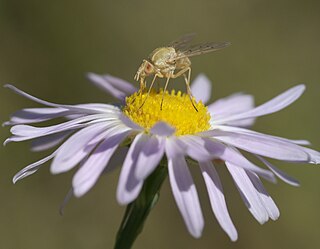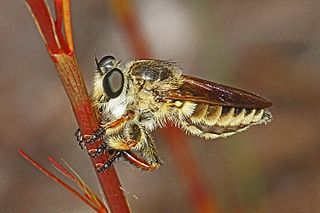
The Scathophagidae are a small family of Muscoidea which are often known as dung flies, although this name is not appropriate except for a few species of the genus Scathophaga which do indeed pass their larval stages in animal dung. The name probably derives from the yellow dung fly, which is one of the most abundant and ubiquitous flies in many parts of the Northern Hemisphere.

The Chamaemyiidae are a small family of acalyptrate flies with less than 200 species described worldwide. The larvae of these small flies are active and predatory and are often used for biological control of aphids, scale insects, and similar pests. Chamaemyiid fossils are poorly represented in amber deposits, but a few examples are known from the Eocene epoch onwards.

Periscelididae is a family of flies.
Probezzia is a genus of biting midges in the family Ceratopogonidae. There are at least 20 described species in Probezzia.

Poecilognathus is a genus of bee flies. There are at least 20 described species in Poecilognathus.
Neochirosia is a genus of dung flies in the family Scathophagidae. There are at least three described species in Neochirosia.

Limnellia is a genus of shore flies in the family Ephydridae.
Orbellia is a genus of flies in the family Heleomyzidae. There are about 13 described species in Orbellia.
Amphicosmus is a genus of bee flies. There are about five described species in Amphicosmus.
Metapogon is a genus of robber flies in the family Asilidae. There are about 13 described species in Metapogon.
Nebritus is a genus of stiletto flies in the family Therevidae. There are at least three described species in Nebritus.
Brachylinga is a genus of stiletto flies in the family Therevidae. There are at least 20 described species in Brachylinga.

Megaphorus is a genus of robber flies in the family Asilidae. There are about 18 described species in Megaphorus.
Paracosmus is a genus of bee flies in the family Bombyliidae. There are about five described species in Paracosmus.
Bithoracochaeta is a genus of house flies, in the family Muscidae. There are about 13 described species in Bithoracochaeta.
Mallochohelea is a genus of biting midges in the family Ceratopogonidae. There are at least 40 described species in Mallochohelea.
Macronychia is a genus of satellite flies in the family Sarcophagidae. There are at least 20 described species in Macronychia.
Phyllomyza is a genus of freeloader flies in the family Milichiidae. There are at least 30 described species in Phyllomyza.





